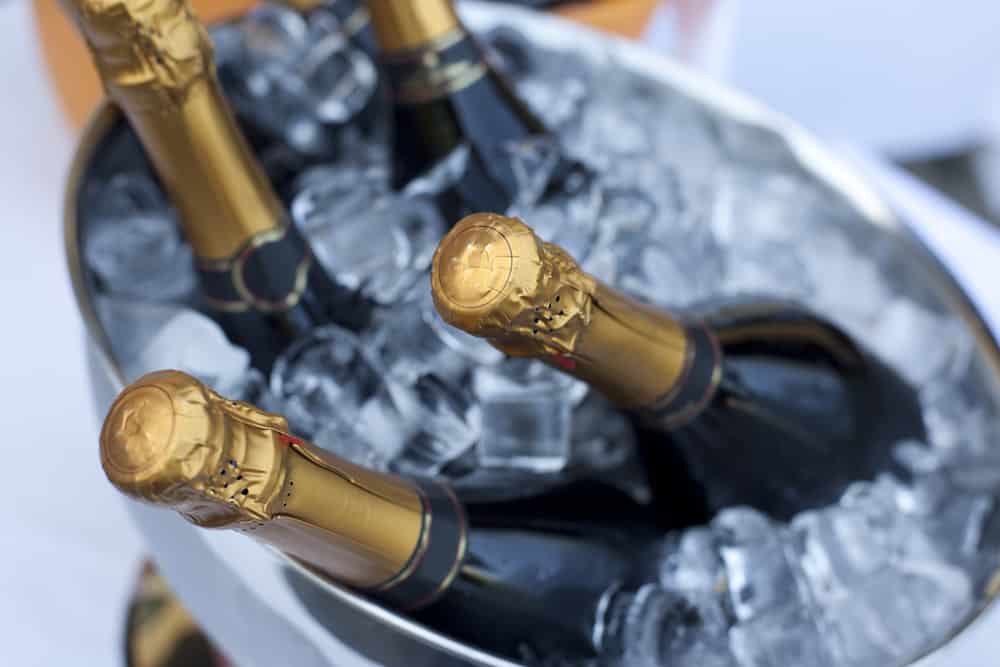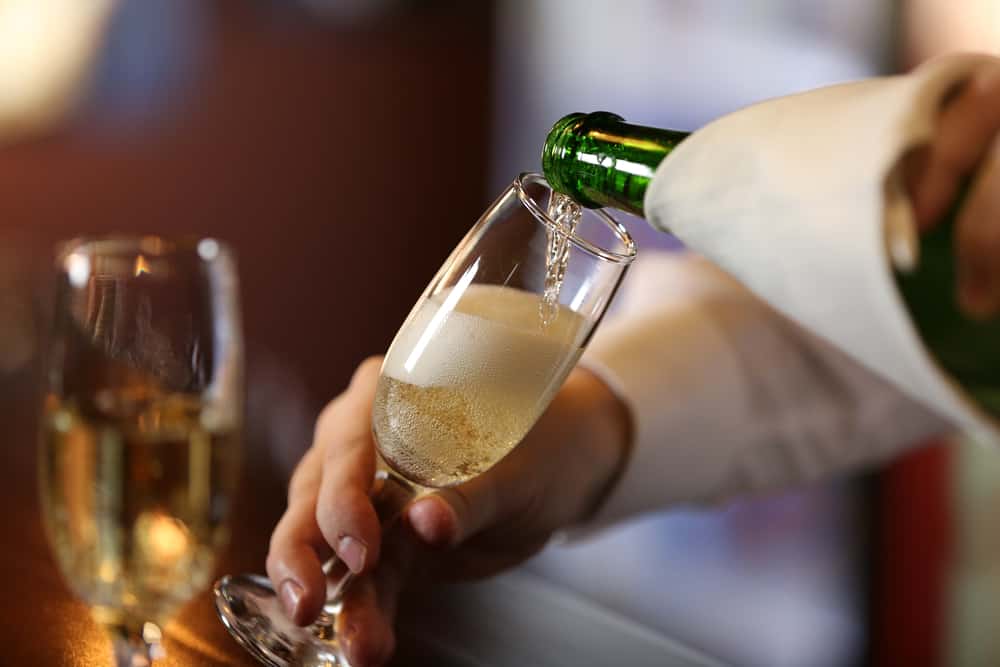Nothing says ‘special occasion’ like a glass of champagne. No birthday, wedding, or anniversary is the same without a perfectly chilled bottle of champagne. But when you don’t drink it all and leave a bottle sitting in the fridge for a while, you may start to wonder whether champagne goes bad. So, does it? Let’s find out.
Table of Contents
Does Champagne Go Bad?
Eventually, yes. Champagne doesn’t age like fine wine. However, going bad doesn’t mean that the bottle becomes unsafe or dangerous to drink. It only loses its signature taste and character.
Once champagne has been opened, it deteriorates quickly as it loses its fizz. Most people will discard such champagne – after all, champagne will not make sense if it is not sparkling!
During production, champagne goes through secondary fermentation, also known as double fermentation, creating carbon dioxide that forms the bubbles we see.
When the bottle is sealed, the carbon dioxide cannot escape. Once the seal is broken and carbon dioxide fizzes out, the quality of the bottle can drop significantly. That’s why experts recommend finishing the bottle the day you open it.
How Long Does Champagne Last?
Champagne, if stored properly, can last a long, long time. However, this shelf life will vary based on the type of champagne. There are two main types of champagne, vintage and non-vintage. Whether a bottle is vintage or non-vintage will depend on the grapes used during production.
Vintage champagne is made from grapes that are harvested within one year while the non-vintage variety is made from a combination of grapes harvested in different years. Non-vintage champagne is also often referred to as sparkling wine. Check the label to see the type of champagne you have.
The vintage bubbly tends to have a longer shelf life than its non-vintage sister. When stored properly, it can last for up to ten years, while non-vintage champagne will last anywhere between three and five years at room temperature.
After the bottle is opened, it will retain its bubbles for four to six days if stored in the refrigerator and sealed tightly. If the champagne stays any longer than this, it will become flat and really not worth consuming.
Here’s a chart that summarizes champagne’s lifespan to help you keep the bubbles in your bubbly.
| Champagne Variety | Lifespan | |
| Pantry | Refrigerator | |
| Unopened vintage champagne | Up to 10 years | N/A |
| Unopened non-vintage champagne | 3 to 5 years | N/A |
| Opened champagne (any variety) | Not recommended | 4 to 6 days |
5 Tips to Tell if Champagne Has Gone Bad
Champagne that doesn’t taste so great can be a party killer. And since un-corking is also part of the fun, it is important to know when the bottle is in the best quality to produce the perfect pop. Here are ways to tell if your champagne has gone bad.
1. Color Change
Good champagne will be pale yellow or light gold in color. If yours has turned deep yellow, gold, or brown, chances are it is overdue.
2. Strange Smell
Sometimes the best way to know for sure whether your champagne is still good is to open the bottle. Pour some of it in a glass, place the glass rim under your nose, and inhale. If it smells like champagne, it’s safe to drink.
It’s good to know what champagne smells like beforehand so you know when the bottle needs discarding. Good champagne will likely smell like freshly baked bread with some hint of wet limestone, but the scent can vary from brand to brand.
3. It’s Flat
If you can’t figure it out from sniffing, try tasting. If it is flat and flavorless, then it is not champagne anymore and there would be no point in drinking it.
4. No Popping Sound
Champagne is known for its signature ‘pop’. If your champagne still got its charm, it will pop when you remove the cork and produce a soft hiss. The absence of pop and bubbles is a sign that your bottle of bubbly has gone bad.
5. Moldy Cork
Champagne can develop mold, forming cloudy sediments at the bottom of the bottle. While this is rare, it could signify that the product has spoiled.
Mold could be introduced by a dirty cork or particles of food finding their way into the bottle. Make sure the cap stays clean and dry at all times and the bottle remains covered when served with food at the dinner table.
For more insights on how to tell if your champagne has gone bad, watch this video:
4 Tips to Store Champagne
Champagne has very specific temperature and light exposure requirements. The following tips will help you ensure your bottle comes out of the pantry or refrigerator with the best taste possible.
1. Store the Bottle Sideways
An effective way to ensure the bottle seals tightly is to keep the cork wet. As with most wines, a champagne cork will dry out if you keep the bottle standing upright for a long time. Sure, storing your champagne this way may save you some space, but if the bottle will be in storage for an extended period, it’s best to keep it horizontally.
2. Avoid Places With Light
Ever wondered why champagne bottles are often dark-colored? It’s because champagne is sensitive to light. Pick a spot that has no windows or use thick curtains to block out the sun. Or cover the bottle with a thick piece of clothing. Exposing champagne to light can make it age prematurely and lose its flavor.
3. Watch the Temperature
The ideal temperature for storing champagne long-term is 50° F, but really, anything between 46° F and 54° F will work just fine. The best place to store your champagne will be the basement, as it’s naturally cool and dark.
How about the refrigerator, you may ask?
Well, it is not the best spot if you are planning to keep the bottle long-term. Under a month is fine for unopened bottles but opened bottles should not stay any longer than six days. Because the temperature of the refrigerator will likely be set to a lower degree to keep other food items fresh, leaving the champagne at that temperature will flatten it and make it unenjoyable.
4. Pick an Area Without Smells
Champagne can absorb the surrounding scents over time, which can alter its taste and flavor. The pantry, for instance, may not be a good place to keep your bubbly, as it can soak up odors from spices and other food items. Also, remember to keep the bottle sealed tightly. It will help keep the smells away while retaining the original quality of the champagne.
To learn more about storing champagne the right way, check out this video:
The Risk of Consuming Expired Champagne
While drinking a small amount of spoiled champagne will not harm you, that does not mean you should ingest it. Champagne can still harbor disease-causing microorganisms if it is not stored properly and has developed mold, for instance.
But whether or not the drink will make you sick will depend on many factors including your age and heath, the type of contamination, and the amount consumed. Spoilage due to microbes can result in food poisoning and when that happens, you may experience symptoms like nausea, stomach cramps, diarrhea, vomiting, fever, and dehydration.
The potential for making you ill is always there, so if you believe your champagne has gone bad, simply discard it, as it will not taste that good either.
Can You Freeze Champagne?
Yes, you can freeze champagne, but it is not recommended, and here is why. For starters, freezing lowers the quality of the champagne significantly, and while you can still drink it, your bubbly will not be as enjoyable as it was before storing it in the freezer.
Another reason is that when champagne freezes, it expands. This can push the cork out, or even worse, break the bottle.
If you are lucky to find the bottle intact, avoid opening it right away, as it can easily explode. Place the bottle at room temperature and wait for it to thaw. However, keep in mind that the drastic temperature change will alter the chemical composition of the liquid, causing it to lose its natural taste.
By the time the bottle is completely thawed, it will likely have lost most of its beautiful fruit characteristics and will taste flat. Along with the lost aromas, your exquisite bottle will likely have a significant reduction in carbon dioxide so it won’t pop.
If you are looking to chill your champagne, don’t put it in the freezer. Instead, prepare a bucket of ice and add some salt, then place the bottle inside for about ten to fifteen minutes.
Summary
Champagne can go bad if left in storage for too long. But how long it takes for this to happen will depend on whether the bottle is vintage or non-vintage. Vintage bottles last longer. Regardless, all two types should be stored in a cool place away from sunlight to extend their shelf life.
Resources
- How Long Does Champagne Last After Opening?
- Shelf Life Basics: Understanding How Long Champagne Lasts
- Does Champagne Go Bad? 4 Warning Signs, Storage Tips
- How to Store and Serve Champagne
- Does Champagne go bad? A bottle can last for years if stored properly

